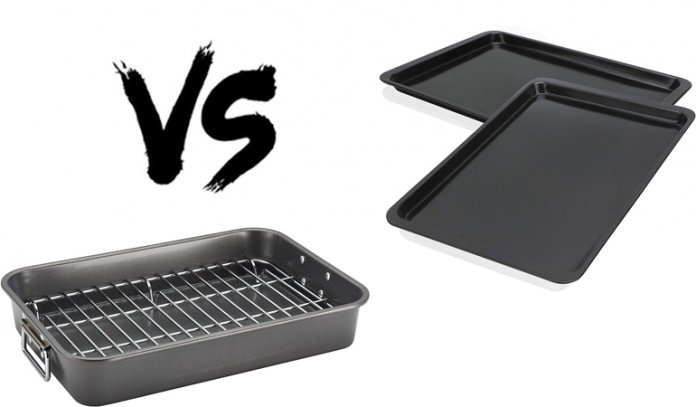Roasting is among the oldest forms of cooking that offer delicious results when done right.
On the other hand, people often consider baking to be a form of science that requires precision and technique. Together, they form the most common food preparation methods used around the world.
If you’re fond of baking, you’ve probably wondered what’s the difference is between a roasting pan vs. a baking pan.
Do they have any major differentiating factors, and can they be used interchangeably? Today, we will answer all of your questions in this thorough comparison between a roasting pan and a baking pan. Let’s dive right in!
Contents
Roasting Pan Vs. Baking Pan – the difference
Most people confuse roasting pans and baking pans as one and the same.
This is because of how subtle their differences are.
Nonetheless, there are several differentiating factors between the two dishes.
They can be categories into the following;
- The material, thickness, and strength of the pans.
- The size and depth (including how high the pan’s walls are).
- The capacity of the pans.
- Presence or absence of a non-stick coating.
To elaborate on the different properties of these two types of pans, we have divided this post into two sections. First, we’ll go over what roasting pans essentially are and their pros and cons.
Then, we’ll do the same for baking pans to help you figure out the exact differences between the two. This offers you a clear perspective on roasting pans vs. baking pans so you can make the right pick for your needs.
What is a Roasting Pan
Roasting pans are oven-safe cookware dishes that come with high walls. They are built to withstand temperature ranges of 350 degrees and above for extended periods of time.
A roasting pan is perfect for cooking large meat cuts, roasting veggies, and finishing off your starch products in the oven.
Your roasting pan will be made of heavy-duty material and reinforced with sturdy non-stick coating or polymers for added strength. This gives the pan exceptional heat conduction and allows it to trap heat inside for a better cook.
Furthermore, since roasting meats often releases juices and proteins, a roasting pan is designed to be able to stand scrubbing and scraping with steel wool. They also come with a rack, so your roast is held above the cooking juices below.
This elevation allows for better air circulation to your food, ensuring an even, thorough cook on all surfaces.
You might find several articles on the internet offering alternatives to use for roasting your meat or veggies. But, only a roasting pan can provide you with that perfectly crisp and golden roast.
Properties of a Typical Roasting Pan
- High range of functionality.
- Sturdy and long-lasting.
- High walls to prevent liquid spillage.
- Larger sizes.
- Comes with a handle.
- Can withstand higher temperatures for longer.
- Made of carbon steel, cast iron, or stainless steel.
- Improved heat conduction.
- Rack for air circulation.
Types You Can Pick From
The most common materials used for roasting pans are aluminum and stainless steel. Both of these materials work exceptionally to distribute heat evenly throughout your food for an even cook. However, some roasting pans do develop hot spots that you’ll need to be vary of.
Another option for roasting pans is a non-stick pan. They can be difficult to clean since you can go at them with a ball of steel wool. However, these pans are perfect for getting a beautiful golden crisp on your roasted meal without any chances of it sticking to the rack.
Lastly, there are cast iron roasting pans that come with enameled surfaces to first brown your meat on the stovetop, then put it in the oven to finish off.
Pros of Roasting Pans
- Thick, heavy-bottomed walls for searing and roasting.
- Heavy-duty, large pans to fit food for the whole family.
- They can be heated directly on the stove with no fear of cracking or shattering.
- Roasting pans look more impressive, offering a wonderfully rustic feel.
- The tall walls are perfect for holding the juices and later using them in gravies or for deglazing.
- They come in huge sizes so that you can cook two chickens or a whole turkey with space for veggies.
Cons of Roasting Pans
- A negative side of the tall walls is that holding juices prevents dry heat.
- Can trap excessive moisture leading to soggy veggies.
- Too bulky for daily use can cause strain on your arms.
- Roasting pans are often quite expensive.
What is a Baking Pan
Contrary to roasting pans, baking pans are more flexible in size and come with lower walls. They are generally made of ceramic or glass and have lower heat tolerance than a roasting pan.
A baking pan’s material isn’t quite as heavy-duty, making them lighter and easier to use. They come without handles and usually include a lid to cover your food as it cooks for heat entrapment.
Your baking pan will be made of a shatter-proof material, making them a wiser choice for novice or young cooks. They are often transparent, so you can keep an eye on the food and make sure it doesn’t overcook.
Furthermore, your baking pans can be transferred to the refrigerator to store loaves of bread or other leftovers to be eaten later.
Properties of a Typical Baking Pan
- Offer a more versatile cooking range.
- Smaller, thinner, and lighter.
- Made of various different materials.
- Comes with a lid.
- Lower walls.
Types You Can Pick From
Baking pans come in a wider variety than roasting pans. Here are some essential types for every kitchen.
- Glass – these are non-reactive and easy-to-use baking dishes that don’t load your food with toxic chemicals. They are also great for storage, so you can have the food later.
- Stoneware – more commonly used by professional chefs for better aesthetics.
- Ceramic – these pans are exceptionally versatile as they can be used on the stove and oven both.
- Stainless steel – great for regular use but you will need to avoid citrusy ingredients.
- Silicone – among the popular choices recently due to its higher safety assurance and no leaching issues.
Pros of Baking Pans
- Lighter and easier to handle for use.
- Baking pans are more compact for easy storage in smaller kitchens.
- They are cheaper and better to be used for novice chefs.
- Baking pans are more multi-purpose and can be used for different types of meals and desserts.
- Your baking pan offers better circulation to the food, ensuring an even cook.
- They come with a lid, so you don’t need to trouble yourself with aluminum sheets.
Cons of Baking Pans
- Baking pans are smaller and lighter than a roasting pan; therefore, they can’t hold hefty meals.
- They don’t come with handles that can risk your hands burning.
Can Roasting Pans and Baking Pans be Used Interchangeably?
Technically, you can use roasting pans for baking goods and vice versa. If you’re looking forward to having a delicious roast chicken for dinner and only have baking pans, it’s absolutely fine! Don’t let the lack of roasting pans stop you from indulging in a delectable meal.
Similarly, if you want to bake something that requires a lid and you only have roasting pans, just use foil as a substitute. It works quite effectively and offers a similar result.
You will just need to be mindful of the differences in their heat retention capacity and make appropriate adjustments to the baking temperature and time.
That being said, it is always a good idea to stock up at least one roasting and baking pan each in your kitchen. It opens up your cooking adventures to more opportunities and lets you experiment with different recipes.
Knowing you have the right dishes for each can help streamline the cooking process as well. Moreover, you won’t need to constantly fiddle with the cooking temperatures and guess your way around it.
A baking pan can never give you that perfect roasted result that roasting pans offer. On the other hand, you need a baking pan for a slow, even cook on your bread or pasta dishes.
Since they usually come with lids, baking pans allow the flavors to fully incorporate, giving your dishes added depth and taste.
Summing it Up
In the end, it is essential to note that investing in both baking pans and roasting pans isn’t really necessary for a novice cook.
If you have just started out in your kitchen, it is probably better for you to take things slow and buy more kinds of pans and dishes as you proceed. This will ensure you don’t get overwhelmed by the technicalities and discouraged to keep experimenting.
You should consider just buying a baking dish to start and trying out different recipes. Baking pans offer more versatility and thus are better for beginners.
Once you have a proper hang on it, you can proceed to roast and other cooking techniques with a roasting
Subtle as they may seem, there are quite significant differences between roasting pans vs. baking pans. Keeping them in mind allows you to pick the right cookware for your recipes to get the best, most tasteful results.
Research well and try to find the best possible roasting and baking pans within your budget, so you get the perfect cook each time.
All the best!


